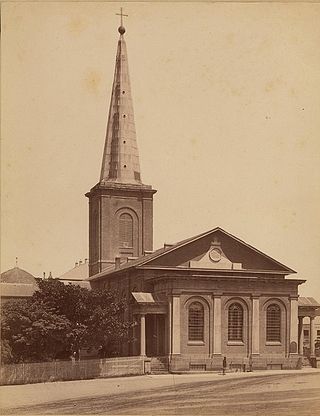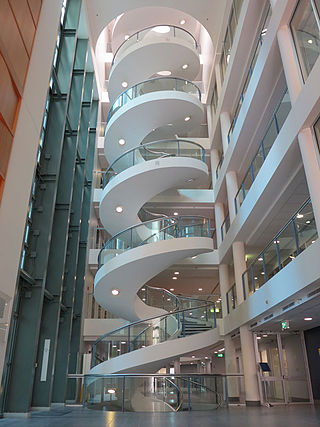
The Sydney Opera House is a multi-venue performing arts centre in Sydney, New South Wales, Australia. Located on the foreshore of Sydney Harbour, it is widely regarded as one of the world's most famous and distinctive buildings and a masterpiece of 20th-century architecture.

Harry Seidler was an Austrian-born Australian architect who is considered to be one of the leading exponents of Modernism's methodology in Australia and the first architect to fully express the principles of the Bauhaus in Australia.

Glenn Marcus Murcutt is an Australian architect and winner of the 1992 Alvar Aalto Medal, the 2002 Pritzker Architecture Prize, the 2009 American Institute of Architects Gold Medal and the 2021 Praemium Imperiale. Glenn Murcutt works as a sole practitioner without staff, builds only within Australia and is known to be very selective with his projects. Being the only Australian winner of the prestigious Pritzker Prize, he is often referred to as Australia's most famous architect.

The New South Wales Government Architect, an appointed officer of the Government of New South Wales, serves as the General Manager of the Government Architect's Office (GAO), a multi-disciplinary consultancy operating on commercial principles providing architecture, design, and engineering services, that is an agency of the government within NSW Public Works.
Janet Laurence is an Australian artist, based in Sydney, who works in photography, sculpture, video and installation art. Her work is an expression of her concern about environment and ethics, her "ecological quest" as she produces art that allows the viewer to immerse themselves to strive for a deeper connection with the natural world. Her work has been included in major survey exhibitions, nationally and internationally and is regularly exhibited in Australia, Japan, Germany, Hong Kong and the UK. She has exhibited in galleries and outside in site-specific projects, often involving collaborations with architects, landscape architects and environmental scientists. Her work is held in all major Australian galleries as well as private collections in Australia and overseas.
Paul Carter is a British academic and writer.
LAB Architecture Studio was a firm of architects and urban designers based in Melbourne, Australia with international offices in London and Shanghai.

Daryl Sanders Jackson is an Australian architect and the owner of an international architecture firm, Jackson Architecture. Jackson also became an associate professor at University of Melbourne and Deakin University.
The Sydney School of Architecture, Design and Planning, also known as The University of Sydney School of Architecture, Design and Planning, formerly the Faculty of Architecture, Design and Planning, is a constituent body of the University of Sydney, New South Wales, Australia. The school was established in 1920.
Richard Anthony Johnson is an Australian architect best known as the creator of some of the Australian most important and iconic cultural buildings and spaces of the twentieth century.

Kenneth Frank Charles Woolley was an Australian architect. In a career spanning 60 years, he is best known for his contributions to project housing with Pettit and Sevitt, four time Wilkinson Award-winning architect, including three times for his own house, the first being the 1962 Woolley House in Mosman, and his longstanding partnership with Sydney Ancher and Bryce Mortlock. He is regarded as being a prominent figure in the development of the Sydney School movement and Australian vernacular building.
Lawrence Nield is an Australian retired architect, who since 2012 has been head of the Heritage Council of New South Wales. He is also known for his writings on urban design. He was head of master planning for the 2000 Sydney Olympic Games. He was one of the founders of BVN Architecture.
Peter Stutchbury is an Australian architect. His architectural expression has been described as "lyrical technologist". In 2015 Stutchbury was awarded the Australian Institute of Architects Gold Medal.
Architectus is one of Australasia's largest design practices, with more than 750 designers and specialists working across nine Australian studios and three affiliated New Zealand studios.
Lovell Chen is an architectural practice and heritage consultancy founded by Peter Lovell and Kai Chen in Melbourne, Victoria, Australia. Founded in 1981 as Allom Lovell & Associates, the practice became Lovell Chen in 2005. They are known for their heritage, conservation and strategic planning work, and latterly for architecture. The practice Principals are Kai Chen, Kate Gray, Peter Lovell, Adam Mornement, Anne-Marie Treweeke, Milica Tumbas and Katherine White.
Ian Stapleton was an Australian heritage architect and a partner at Lucas, Stapleton, Johnson and Partners Pty Ltd. a heritage architectural firm in Australia. Stapleton carried out and contributed to heritage projects throughout Australia, including the Woolloomooloo Finger Wharf, Walsh Bay Redevelopment, the Sydney GPO and Officials’ houses at Port Arthur, Tasmania. He was also active in the National Trust of Australia, the NSW Heritage Council and Australia ICOMOS. Stapleton also published works on Australian architectural styles and was a visiting lecturer at various Sydney schools of architecture and building.
Helen Marian Lochhead is an Australian architect and urbanist who combines academic and expert advisory roles with practice. Her career has focused on the inception, planning, design, and delivery of complex urban projects ranging from city improvements programs to major urban regeneration projects. She has held numerous influential roles in government, industry and universities including Dean, Faculty of Built Environment and Pro Vice-Chancellor Precincts at UNSW Sydney, National President of the Australian Institute of Architects and Deputy Government Architect in NSW. She has served on various Panels and Boards including the NSW Independent Planning Commission, The Australian Heritage Council and the National Capital Authority.
Laura Harding is an Australian architectural practitioner and critic. Harding works across architecture and urban design, with a particular focus on the public realm. She is also an architectural critic and an active participant in the public culture of architecture. Harding regularly contributes to architectural education as a visiting critic at the University of New South Wales and the University of Sydney. From 2006 to 2012, she taught with Glenn Murcutt in the third year design program at the University of New South Wales.

Peter Brian Hall was an Australian architect active in Sydney and elsewhere from the 1950s to the early 1990s. Schooled in the tenets of modernism his practice was also informed by a strong sense of the importance of function and context in design. During his early years Hall was the recipient of numerous education scholarships and bursaries, most notably a traineeship and then employment with the office of the New South Wales Government Architect, a source of highly creative architecture during the 1960s. However, Hall is best known for completing the Sydney Opera House after the resignation of its original architect, Jørn Utzon, in February 1966. At the age of 34, he was invited by the Government Architect to act as design architect in the newly formed consortium Hall Todd & Littlemore to resolve the issues which had led to Utzon's resignation, principally the design of all the interiors and the enclosing glass walls of the unfinished building. The Opera House opened in October 1973 and despite its subsequent success as Sydney's most popular performance venue, understanding of the work of Hall and his team has been coloured by the controversial circumstances of their appointment. For Hall, both personally and professionally, Utzon's legacy was a poisoned chalice – an unprecedented challenge to complete the building to a standard commensurate with its sublime exterior, but one that brought little recognition during his lifetime.
The Embassy of Sweden in Canberra is Sweden's diplomatic mission in Australia. The embassy opened in 1947 and has been located in Canberra since 1951. The ambassador since 2022 is Pontus Melander.






